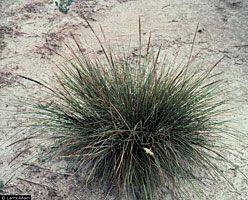Gulf Cordgrass

© Larry Allain
Spartina spartinae
Family: Poaceae (Grass Family)
Gulf Cordgrass (Spartina spartinae) is a tough, clump-forming native bunchgrass found along the Gulf Coast and throughout the southern U.S. It thrives in salty and brackish environments, making it a vital component of coastal prairies and marsh restoration projects. Its stiff, arching blades and tall flowering stalks provide essential habitat and food for wildlife.
- Scientific Name: Spartina spartinae
- Common Names: Gulf Cordgrass, Sacahuista
- Family: Poaceae (Grass Family)
- Growth Habit: Perennial bunchgrass
- Height: 3 to 6 feet
- Leaves: Long, narrow, rough-edged blades that arch outward
- Flowers: Small, inconspicuous flowers on tall stalks
- Bloom Time: Summer to early fall
- Wildlife Benefits: Provides nesting cover, food, and shelter for birds and other wildlife
Habitat & Range in Southeast Texas
Gulf Cordgrass is commonly found in:
- Coastal Prairies: Dominant in Gulf Coast prairie ecosystems
- Salt and Brackish Marshes: Tolerates saline soils and occasional flooding
- Roadsides & Ditches: Can colonize disturbed, salty soils
This grass is highly tolerant of drought, wind, and salt exposure, making it ideal for harsh environments.
Ecological Importance
- Erosion Control: Strong root system stabilizes coastal soils and prevents erosion
- Habitat Value: Provides critical cover for ground-nesting birds, amphibians, and small mammals
- Fire Resilience: Recovers quickly after fire and supports prairie ecosystem health
Landscaping & Gardening Uses
Gulf Cordgrass is an excellent choice for natural landscapes and restoration projects:
- Prairie Restoration: Integral species in coastal prairie projects
- Buffer Strips & Bioswales: Controls runoff and filters water in stormwater projects
- Habitat Gardens: Adds structure and movement to native plantings
Planting & Care
- Sunlight: Full sun
- Soil: Prefers salty or alkaline, well-drained to periodically wet soils
- Water Needs: Low to moderate once established; tolerates occasional flooding
- Maintenance: Very low; may be cut back in late winter to encourage fresh growth
- Companion Plants: Matches well with Eastern Gamagrass (Tripsacum dactyloides), Bushy Bluestem (Andropogon glomeratus), and Saltmarsh Mallow (Kosteletzkya virginica)
Fun Facts
- Gulf Cordgrass is also known by its Spanish-derived name "sacahuista," meaning "bag grass" due to its fibrous leaves.
- The dense, fibrous clumps were traditionally used by Indigenous peoples for basketry and insulation.
- It's one of the most salt-tolerant native grasses in Texas.
Conservation & Native Plant Advocacy
Using Gulf Cordgrass in landscapes and restoration projects supports biodiversity, improves water quality, and helps restore fragile coastal prairies and marshes. Its resilience makes it a strong candidate for sustainable landscaping.
Where to Find It
-
Interested in adding Gulf Cordgrass to your garden? Check if this is in stock or add to cart to purchase directly from our Natives Nursery.


